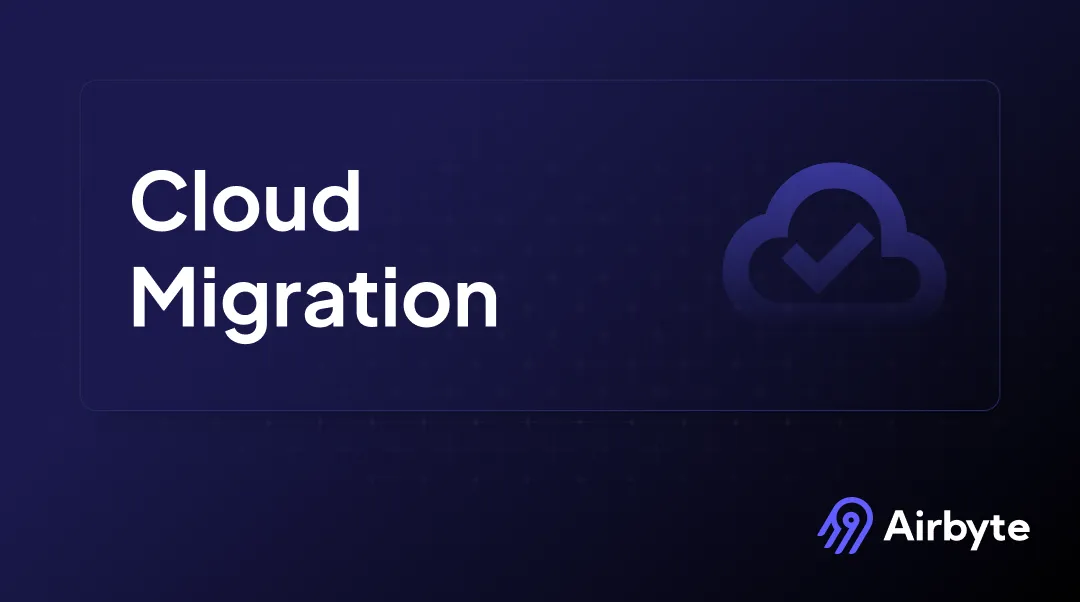Cloud Migration: Your 2025 Guide (Approaches, Pros & Cons)
Summarize this article with:
✨ AI Generated Summary
The cloud migration trend is accelerating, driven by benefits like scalability, cost savings, and enhanced security, with public cloud spending expected to grow 20.4% in 2024. Key migration approaches include rehosting, replatforming, refactoring, repurchasing, retiring, and retaining applications, each suited to different business needs.
- Major providers: AWS, Microsoft Azure, and Google Cloud Platform offer diverse tools and services for migration.
- Cloud migration pros: reduced upfront costs, improved remote access, and strong security measures.
- Cons: potential hidden costs, vendor lock-in, and data security concerns.
- Airbyte simplifies data migration with 350+ connectors, CDC for efficient syncing, and customizable integration options.
The cloud revolution is in full swing, with businesses increasingly migrating their data applications and services away from on-premise infrastructure. This shift is driven by a compelling set of advantages—scalability, agility, cost-effectiveness, and enhanced security. According to a report by Garter, the worldwide end-users spending on public cloud services is forecast to grow 20.4% in 2024. But migrating to the cloud isn’t a one-size-fits-all proposition. There are various approaches to consider, each with its benefits and drawbacks.
This comprehensive guide will equip you with the knowledge you need to navigate your cloud migration journey in 2025. It covers different migration strategies, delves into their pros and cons, and assists you in choosing the optimal path for your organization.
What is Cloud Migration?

Cloud migration involves moving your company’s digital assets, such as applications, data, and IT resources, from on-premise servers to the cloud. It can be a complete or partial migration, and in some cases, it also involves moving from one cloud provider to another.
While the core concept of cloud migration remains consistent across providers, companies in finance, healthcare, IT, manufacturing, and other industries might employ different strategies based on their specific requirements.
Here are some major cloud service providers:
- Amazon Web Services (AWS): AWS offers a wide range of migration tools and services, such as AWS Migration Hub, AWS DMS, and AWS Application Migration Service (MGN). They strongly encourage a cloud-native development approach to leverage its full suite of services. Leaders like Ferrari, Formula 1, Intuit, Moderna, NASA, the NHL, etc., choose AWS to help them increase agility and scalability and accelerate innovation.
- Microsoft Azure: Azure provides different migration tools, including Azure Database Migration Service and Azure Migrate. One of these, Azure Migrate, simplifies your entire migration process by acting as a central hub for assessment. Here, you can evaluate your on-premises workloads (servers, databases, web apps) and determine their migration suitability. It integrates with various storage options, like Azure Blob Storage, Azure Data Box, and more. To maximize the efficiency of these tools and ensure proficiency, obtaining the necessary certification is essential. For this, you can use DP-203 Exam Dumps and practice test questions. It will boost your learning process and ensure you get the necessary certifications with ease.
- Google Cloud Platform (GCP): GCP is a cloud service provider offering several cloud migration services. GCP provides several tools and services to help you migrate your data and applications to the cloud, including Google Cloud VMware Engine, Cloud Foundation Toolkit, Cloud SQL, and BigQuery Transfer Service. Industry leaders like 20th Century Fox, AFL, Accionia Mobility, Wendy’s, Ginkgo Bioworks, etc., use GCP to increase their data quality and faster analysis.
Cloud Migration Approaches

Cloud migration approaches include various strategies and techniques for smoothly transitioning applications, data, and processes from on-premises infrastructure to cloud environments. These strategies are pivotal for your organization if you want to leverage the scalability, flexibility, and cost-effectiveness offered by cloud computing. Below are some common cloud migration approaches:
Rehost (Lift and Shift)
Lift and Shift is the most straightforward approach, where applications and data are moved to the cloud with minimal changes. This is often called lift and shift because you are essentially lifting your entire IT infrastructure and shifting it to the cloud provider’s data center. This approach is often chosen for its simplicity, speed, and minimal downtime during migration. Workloads that require expensive hardware (e.g., graphic cards or HPC) can be moved directly to specialized virtual machines in the cloud for tasks like advanced graphics processing.
Replatform
In replatform, the application is migrated to the cloud, and its underlying infrastructure is rebuilt to leverage cloud-native features. It offers more scalability and flexibility than lift and shift. Replatforming involves modifying the application code to utilize cloud-based services and features.
Refactoring
The refactor cloud migration strategy represents a substantial transformation. Applications undergo a comprehensive redesign to maximize the cloud’s built-in attributes, like elasticity, scalability, and managed service. This approach is unquestionably the most intricate and time-consuming, but it also provides the greatest advantages in terms of cost minimization and agility.
Repurchase
Repurchase is also known as drop and shop. You swap out your application for a newer model or service. The new application, which features pay-as-you-go pricing options, accessibility from any location, and no infrastructure to manage, offers more commercial value than the current on-premises version. Repurchasing the application usually lowers infrastructure, licensing, and maintenance costs.
Retire
This strategy is centered on maximizing resource consumption and streamlining the cloud environment. After a comprehensive investigation, applications determined to be outdated are withdrawn from the migration process. Doing so may lessen the effort and resource consumption in the cloud environment by avoiding moving apps that are no longer essential.
Retain
This approach recognizes that only some applications are suitable for moving to the cloud. Applications may be maintained on-premises for various reasons, including technological dependencies requiring easier handling in a cloud environment, security concerns, or compliance requirements. Preserving certain on-premises programs guarantees their continued operation while resolving certain difficulties related to cloud migration.
When Should You Opt for Cloud Migration for Your Business?
There are several signs that you should consider cloud data migration. Here are some key factors:
Scalability Needs
As your customer base or data volume expands, on-premise systems may struggle to keep pace. The cloud’s limitless scalability allows you to add or remove resources as your needs evolve.
Cost Considerations
Managing your hardware and software can be expensive at times. Cloud migration can reduce IT costs by eliminating the need to purchase and maintain physical servers, software licenses, and data center space. This allows you to only pay for the resources you use. In addition, cloud providers handle maintenance and upgrades, freeing up your IT team to focus on strategic initiatives.
Security and Compliance
When your organization lacks the in-house expertise to secure its on-premise infrastructure properly, it faces challenges in holding sensitive data. Cloud providers typically invest heavily in security and offer a wide range of features to address these challenges effectively. They adhere to measures such as HIPAA, ESIC, GDPR, etc, to meet specific industry compliance requirements.
Is Cloud Migration the Right Choice for You?
Cloud migration offers significant benefits for your business but is not without challenges. By carefully considering the pros and cons, assessing your specific needs, and developing a well-defined migration plan, you can decide whether cloud migration is the right path for your organization.
Pros of Cloud Migration
The Pros of cloud migration includes:
- It eliminates the need for upfront investment in hardware, software licenses, and IT staff augmentation for maintenance. You typically pay for the resources you use, which leads to potential cost reductions.
- Cloud providers handle infrastructure updates and software patching, freeing your IT team to focus on the strategic initiative.
- Cloud-based applications and data can be accessed from anywhere via the Internet, allowing for greater remote work possibilities and improved collaboration.
- Cloud providers invest heavily in security measures and disaster recovery solutions, potentially offering better protection for your data than on-premises infrastructure.
Cons of Cloud Migration
Cons of a cloud migration involve:
- While cloud services offer pay-as-you-go models, data access fees, API calls, and unexpected resource usage can add up. Careful cost monitoring and management are needed.
- Once you migrate to a cloud platform, switching to another provider can be complex and costly. Consider evaluating your needs cautiously and choosing a flexible platform that meets your long-term goals.
- Even though cloud providers offer robust security, migrating sensitive data to the cloud can raise concerns for your business. Understanding the provider's security protocols and data encryption practices is crucial.
Airbyte: Your Ally in Cloud Migration

Migrating to the cloud involves seamlessly moving your data to a new environment. This process can be complex, but Airbyte, a data integration platform, can be a valuable tool to simplify your cloud migration journey.
As your data can be segregated on different platforms, it can be tedious to individually load it from each dataset to the desired cloud destination. Airbyte is a medium that helps you integrate structured, unstructured, or semi-structured data formats into a single platform. It enables you to bridge your on-premises data and your targeted cloud platform.
Hers’ how Airbyte helps in migrating your data to the cloud:
- Airbyte has a vast library of 350+ pre-built connectors for various SaaS applications, databases, data lakes, and data warehouses. With these connectors, you can effortlessly extract your on-premise or cloud data and load it into a single central location.
- If you can’t find the connector according to your requirements, Airbyte’s Connector Development Kit (CDK) allows you to build your own custom connectors. This ensures all your data sources can be seamlessly integrated during migration.
- Airbyte utilizes the CDC (Change Data Capture) feature, which only captures the changes made to your data since the last migration. This minimizes data transfer time, optimizing the migration process.
- You can specify how Airbyte must handle the sources' schema changes for each connection. This process helps ensure accurate and efficient data syncs, minimize errors, and save time and effort in managing your data pipelines.
Conclusion
Migrating data to cloud migration will offer significant advantages, such as optimized cost, flexibility, scalability, etc., for your business in 2024. By understanding the different approaches, weighing the pros and cons, and carefully planning your strategy, you can ensure a smooth and successful migration journey.

